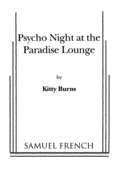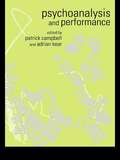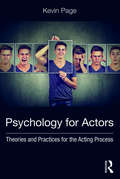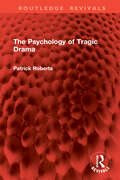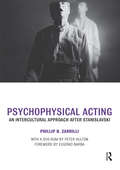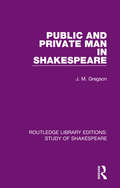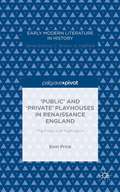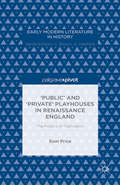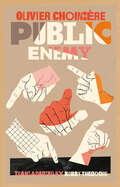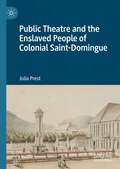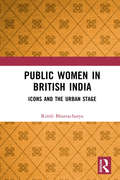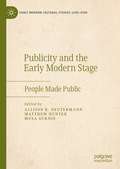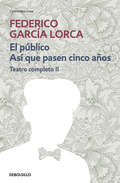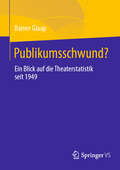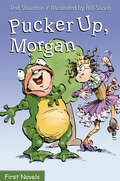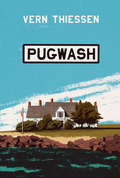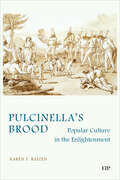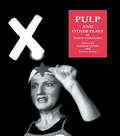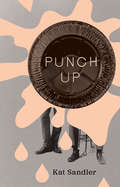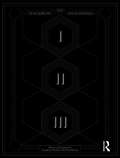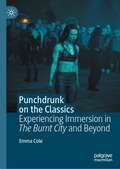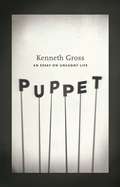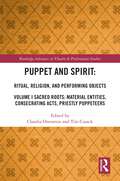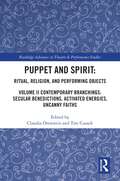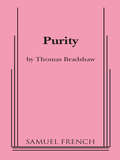- Table View
- List View
Psycho Night at the Paradise Lounge
by Kitty BurnsMystery / 9m, 7f / Interior / Four customers and their friends are at the Paradise Lounge to murder the singer. They do not know each other and are unaware of each other's evolving plots. As Cindy sings, the villains discuss with their accomplices the reasons and methods they've devised for her demise. One by one, four traps are set in Cindy's dressing room. At the end of Act I, Cindy leaves the stage and a commotion is followed by a scream from the direction of the dressing room. The police arrive to investigate and instruct the customers to remain in the lounge while they question staff in the office. With the police out of sight, each potential murderer returns to the dressing room to remove evidence. Each springs a fiendish trap set by another and dies, leaving the police with four bodies, a variety of unusual murder weapons and a room full of "silent partners" who are no help in unraveling the mystery.
Psychoanalysis and Performance
by Patrick Campbell Adrian KearThe field of literary studies has long recognised the centrality of psychoanalysis as a method for looking at texts in a new way. But rarely has the relationship between psychoanalysis and performance been mapped out, either in terms of analysing the nature of performance itself, or in terms of making sense of specific performance-related activities. In this volume some of the most distinguished thinkers in the field make this exciting new connection and offer original perspectives on a wide variety of topics, including: · hypnotism and hysteria · ventriloquism and the body · dance and sublimation · the unconscious and the rehearsal process · melancholia and the uncanny · cloning and theatrical mimesis · censorship and activist performance · theatre and social memory. The arguments advanced here are based on the dual principle that psychoanalysis can provide a productive framework for understanding the work of performance, and that performance itself can help to investigate the problematic of identity.
Psychology for Actors: Theories and Practices for the Acting Process
by Kevin PagePsychology for Actors is a study of modern psychology, specifically designed for the working actor and actor-in-training, that covers discrete areas of psychological theory that actors can apply to their creative process to form and connect with characters. The book investigates many post-Stanislavsky ideas about human psychology from some of the twentieth century’s most brilliant minds – from Sigmund Freud and Carl Jung to Abraham Maslow and Ken Wilber – and offers step-by-step exercises to help actors understand their characters and effectively bring them to life on stage or in front of the camera. Psychology for Actors also offers advice on how to cope with the stresses and strains of a highly competitive field, and provides tools for deeper self-awareness and character exploration.
The Psychology of Tragic Drama (Routledge Revivals)
by Patrick RobertsFirst published in 1975, The Psychology of Tragic Drama offers an interpretation of some of the themes of both ancient and modern tragic drama through an investigation of the plays in the light of psychoanalytical ideas.In his introduction, the author explains and defends the application of psychoanalytical insights to the study of literature. Then in the first part of the book, he proceeds to an exploration of some primitive and infantile situations expressed in Euripides’ Bacchae and in a group of modern dramas by Strindberg, Pinter, Ionesco and Weiss. In the second part he turns to the drama of Aeschylus, Sophocles and Euripides, tracing the psychological history of Orestes and Electra from their Greek originals to their later re-creations in more modern settings, in the plays of O’Neill, Eliot and Sartre, and comparing the treatment of themes and motifs which also reappear in Macbeth and Hedda Gabler. In conclusion, Patrick Roberts discusses the loss and gain involved in the diffused awareness among modern dramatists of psychoanalytical ideas and influence; indeed, the book as a whole stands as a confirmation and expansion of Freud’s comment ‘that poets and philosophers before me discovered the unconscious’. As such, it will appeal not only to all students of serious drama but to all those interested in the two disciplines of literature and psychoanalysis.
Psychophysical Acting: An Intercultural Approach after Stanislavski
by Phillip B. ZarrilliPsychophysical Acting is a direct and vital address to the demands of contemporary theatre on today’s actor. Drawing on over thirty years of intercultural experience, Phillip Zarrilli aims to equip actors with practical and conceptual tools with which to approach their work. Areas of focus include:an historical overview of a psychophysical approach to acting from Stanislavski to the presentacting as an ‘energetics’ of performance, applied to a wide range of playwrights: Samuel Beckett, Martin Crimp, Sarah Kane, Kaite O’Reilly and Ota Shogoa system of training though yoga and Asian martial arts that heightens sensory awareness, dynamic energy, and in which body and mind become onepractical application of training principles to improvisation exercises.Psychophysical Acting is accompanied by Peter Hulton’s downloadable resources featuring exercises, production documentation, interviews, and reflection.
Public and Private Man in Shakespeare (Routledge Library Editions: Study of Shakespeare)
by J. M. GregsonThe potential duality of human character and its capacity for dissembling was a source of fascination to the Elizabethan dramatists. Where many of them used the Machiavellian picture to draw one fair-faced scheming villain after another, Shakespeare absorbed more deeply the problem of the tensions between the public and private face of man. Originally published in 1983, this book examines the ways in which this psychological insight is developed and modified as a source of dramatic power throughout Shakespeare’s career. In the great sequence of history plays he examines the conflicting tensions of kingship and humanity, and the destructive potential of this dilemma is exploited to the full in the ‘problem plays’. In the last plays power and virtue seem altogether divorced: Prospero can retire to an old age at peace only at the abdication of all his power. This theme is central to the art of many dramatists, but in the context of Renaissance political philosophy it takes on an added resonance for Shakespeare.
‘Public’ and ‘Private’ Playhouses in Renaissance England: The Politics of Publication (Early Modern Literature in History)
by Eoin Price‘Public’ and ‘Private’ Playhouses in Renaissance England.
‘Public’ and ‘Private’ Playhouses in Renaissance England: The Politics of Publication (Early Modern Literature in History)
by Eoin PriceAt the start of the seventeenth century a distinction emerged between 'public', outdoor, amphitheatre playhouses and 'private', indoor, hall venues. This book is the first sustained attempt to ask: why? Theatre historians have long acknowledged these terms, but have failed to attest to their variety and complexity. Assessing a range of evidence, from the start of the Elizabethan period to the beginning of the Restoration, the book overturns received scholarly wisdom to reach new insights into the politics of theatre culture and playbook publication. Standard accounts of the 'public' and 'private' theatres have either ignored the terms, or offered insubstantial explanations for their use. This book opens up the rich range of meanings made available by these vitally important terms and offers a fresh perspective on the way dramatists, theatre owners, booksellers, and legislators, conceived the playhouses of Renaissance London.
Public Enemy
by Olivier ChoinièreThree generations of a family argue over current events, finances, and culture, with everyone looking to blame someone else for society’s ills in this satirical examination of how judgment can both divide and unite people. Elizabeth, the matriarch, has invited her children and grandchildren over for dinner. Instead of a nice family meal, it quickly slides into the adults arguing in the dining room and the kids fighting in the living room. Rapid-fire dialogue fuses and overlaps, but no one listens to each other. A blistering take on the family drama, Public Enemy asks, who’s really responsible for all our suffering?
Public Theatre and the Enslaved People of Colonial Saint-Domingue
by Julia PrestThe French colony of Saint-Domingue (now Haiti) was home to one of the richest public theatre traditions of the colonial-era Caribbean. This book examines the relationship between public theatre and the enslaved people of Saint-Domingue—something that is generally given short shrift owing to a perceived lack of documentation. Here, a range of materials and methodologies are used to explore pressing questions including the ‘mitigated spectatorship’ of the enslaved, portrayals of enslaved people in French and Creole repertoire, the contributions of enslaved people to theatre-making, and shifting attitudes during the revolutionary era. The book demonstrates that slavery was no mere backdrop to this portion of theatre history but an integral part of its story. It also helps recover the hidden experiences of some of the enslaved individuals who became entangled in that story.
Public Women in British India: Icons and the Urban Stage
by Rimli BhattacharyaThis book foregrounds the subjectivity of ‘acting women’ amidst violent debates on femininity and education, livelihood and labour, sexuality and marriage. It looks at the emergence of the stage actress as an artist and an ideological construct at critical phases of performance practice in British India. The focus here is on Calcutta, considered the ‘second city of the Empire’ and a nodal point in global trade circuits. Each chapter offers new ways of conceptualising the actress as a professional, a colonial subject, simultaneously the other and the model of the ‘new woman’. An underlying motif is the playing out of the idea of spiritual salvation, redemption and modernity. Analysing the dynamics behind stagecraft and spectacle, the study highlights the politics of demarcation and exclusion of social roles. It presents rich archival work from diverse sources, many translated for the first time. This book makes a distinctive contribution in intertwining performance studies with literary history and art practices within a cross-cultural framework. Interdisciplinary and innovative, it will appeal to scholars and researchers in South Asian theatre and performance studies, history and gender studies.
Publicity and the Early Modern Stage: People Made Public (Early Modern Cultural Studies 1500–1700)
by Matthew Hunter Allison K. Deutermann Musa GurnisWhat did publicity look like before the eighteenth century? What were its uses and effects, and around whom was it organized? The essays in this collection ask these questions of early modern London. Together, they argue that commercial theater was a vital engine in celebrity’s production. The men and women associated with playing—not just actors and authors, but playgoers, characters, and the extraordinary local figures adjunct to playhouse productions—introduced new ways of thinking about the function and meaning of fame in the period; about the networks of communication through which it spread; and about theatrical publics. Drawing on the insights of Habermasean public sphere theory and on the interdisciplinary field of celebrity studies, Publicity and the Early Modern Stage introduces a new and comprehensive look at early modern theories and experiences of publicity.
El público | Así que pasen cien años (Teatro completo #2)
by Federico García LorcaEl público | Así que pasen cinco años es el quinto volumen de la Biblioteca Federico García Lorca y el segundo que reúne su «Teatro completo». En este libro se ofrecen al lector clásicos lorquianos como Amor de don Perlimplín, así como aquello que se dio en llamar el «teatro irrepresentable»: El público y Así que pasen cinco años. Asimismo, se incluyen conferencias y charlas dadas por el poeta alrededor de sus textos, lo que permite una aproximación aún más personal a su inmensa obra. La edición y los prólogos, a cargo de Miguel García-Posada, permiten al lector acercarse a la complejidad de su obra y disfrutar, a lo largo de los siete volúmenes que componen esta Biblioteca Federico García Lorca, de uno de los autores españoles más relevantes del siglo XX. Salvador Dalí dijo...«El sentido trágico de la vida que poesía Lorca se distinguía por la misma constante trágica por que se distingue el destino de todo el pueblo español.» --------------------------------------------------------------------------BIBLIOTECA FEDERICO GARCÍA LORCA Poesía competa:1. Libro de poemas | Primeras canciones | Canciones2. Romancero gitano | Poema del cante jondo3. Poeta en Nueva York | Sonetos Teatro completo:4. La zapatera prodigiosa | Mariana Pineda5. El público | Así que pasen cinco años6. Bodas de sangre | Yerma7. La casa de Bernarda Alba | Doña Rosita la soltera--------------------------------------------------------------------------
Publikumsschwund?: Ein Blick auf die Theaterstatistik seit 1949
by Rainer GlaapDurch den teils massiven Publikumsschwund nach der Pandemie stellt sich die Frage, ob diese als Brandbeschleuniger gewirkt hat für bereits vorhandene Trends. Der Autor geht dem nach anhand der Besuchszahlen bis zur letzten vollständigen vorpandemischen Spielzeit 2018/19. Er zeigt historische Zeitreihen zu Sparten- und Personalentwicklung, Vertriebskanälen und den Einnahmen. Die Theaterstatistik des Bühnenvereins dient vielen Entscheidungsträgern als Grundlage für z.B. kulturpolitische Steuerungen, obwohl sie nicht die komplette deutsche Theaterlandschaft abbildet. Deshalb beleuchtet der Autor weitere Anbieter. Da die Theaterstatistik große kulturpolitische Bedeutung hat, gibt es zum Schluss einige Vorschläge für die Zukunft.
Pucker Up, Morgan (Formac First Novels)
by Ted StauntonMorgan is delighted to have the lead role in The Frog Prince even if he has to kiss Aldeen, the Godzilla of Grade Three, to turn into a prince. They both agree smooching is gross. Despite Aldeen's threats and Morgan's overreacting they manage to create an unexpected twist to the play. Morgan discovers that teamwork makes a better performance.
Pugwash
by Vern Thiessen1957. Barely a decade after the first use of atomic bombs, the world is divided and fearful of the real threat of nuclear weaponry. In an effort to understand the devastating effects of radiation, leading scientists and academics—world-renowned “Thinkers”—are invited to a conference in the small town of Pugwash, Nova Scotia. Two local children, Conni and Jamie, take interest in some of the Thinkers, who are humbled by their innocent welcome. But a spy disguised as a reporter has conned Jamie for information to use against the Thinkers, putting the entire conference—and the town of Pugwash—at risk.
Pulcinella’s Brood: Popular Culture in the Enlightenment (Toronto Italian Studies)
by Karen T. RaizenPulcinella, a Neapolitan clown born of the commedia dell’arte tradition, went viral in Europe in the seventeenth and eighteenth centuries. He was an unlikely hero, grotesque in his mannerisms, with a bulging belly, occasional hunchback, and an insatiable desire for macaroni. Still, this bulbous misfit took his place next to kings, caliphs, and intellectual heavyweights. Pulcinella’s Brood traces the transnational arc of the Enlightenment-era Pulcinella, from his native Naples to Paris, from Rome to London. The book explores how Pulcinella was inserted into discourses about social order, aesthetics, and politics – how he became a revolutionary, a critic of the Catholic Church, and a champion of education. It examines how Pulcinella, along with his transnational brood, was a constant, pervasive presence during the Enlightenment and a squeaky-voiced participant in the ideological and theoretical debates that defined the era. Exploring the diffusion of Italian popular comedy throughout Europe, Pulcinella’s Brood proposes that Pulcinella, a grotesque, food-obsessed clown, can be wielded as a historical disruptor and a rich and dynamic source for casting both the Enlightenment and our contemporary world in a different light.
Pulp and Other Plays by Tasha Fairbanks
by Elaine Aston Gabriele GriffinFirst Published in 2004. Routledge is an imprint of Taylor & Francis, an informa company.
Punch Up
by Kat Sandler SandlerDuncan has always been a pretty boring guy, leading a simple life while working at a bread factory. Then he stumbles upon Brenda, a sad young woman who’s about to end her life. Convinced he’s fallen in love, Duncan strikes up a desperate deal: if he can get her to laugh, she'll give life another shot, but if she doesn’t even giggle, he'll help her go through with her plan. There’s just one catch: Duncan isn’t funny. At all. So he borrows Pat, his second-favourite comedian, to help him come up with the perfect routine. But Pat is having a hard time mustering his sense of humour after a bad break-up, and the last thing he wants to do is teach a lonely loser the difference between knock-knock jokes and schadenfreude while chained to a typewriter. A tragicomedy of three misfits, Punch Up navigates a hostage situation and a life-or-death comedy lesson to show just how far we’ll go for a laugh.
The Punchdrunk Encyclopaedia
by Josephine MachonThe Punchdrunk Encyclopaedia is the definitive book on the company’s work to date, marking eighteen years of Punchdrunk’s existence. It provides the first full-scale, historical account of one of the world’s foremost immersive theatre companies, drawn from unrivalled access to the collective memory and archives of their core creative team. The playful encyclopaedic format, much like a Punchdrunk masked show, invites readers to create their own journey through the ideas, aesthetics, contexts, and practices that underpin Punchdrunk’s work. Interjections from Felix Barrett, Stephen Dobbie, Maxine Doyle, Peter Higgin, Beatrice Minns, Colin Nightingale and Livi Vaughan, among others, fill out the picture with in-depth reflections. Charting Punchdrunk’s rise from the fringe to the mainstream, this encyclopaedia records the founding principles and mission of the company, documenting its evolving creative process and operational structures. It has been compiled to be useful to scholars and students from a variety of backgrounds and disciplines, from secondary level through to doctoral research, and is intended for those with a fascination for theatre in general and immersive work in particular. Ultimately it is written for those who have dared to come play with Punchdrunk across the years. It is also offered to the curious; those adventurers ready and waiting to be immersed in Punchdrunk worlds.
Punchdrunk on the Classics: Experiencing Immersion in The Burnt City and Beyond
by Emma ColePunchdrunk on the Classics: Experiencing Immersion in The Burnt City and Beyond draws attention to Punchdrunk’s use of ancient Greek literature in their creation of immersive theatre. The book documents and analyses the effects of utilising Greek tragedy within both Punchdrunk’s creative development windows, and the company’s final staged productions. It features material stretching from The House of Oedipus (2000) right through to The Burnt City (2022-23), on which the author worked as dramaturg. Chapters include rehearsal studies, explorations of how Greek literature can shape an audience’s experience in immersive theatre, and considerations of how The Burnt City might change our understanding of the poetics of immersion in antiquity. Overall, Punchdrunk on the Classics provides an unparalleled depth of insight into an individual Punchdrunk production, and highlights the until-now overlooked significance of antiquity within Punchdrunk’s practice.
Puppet: An Essay on Uncanny Life
by Kenneth Gross&“Offering endless insights into the strange and archaic world of puppets . . . This is a book of literary mysticism, rich with accrued culture.&” —John Rockwell, The New York Times Book Review The puppet creates delight and fear. It may evoke the innocent play of childhood, or become a tool of ritual magic, able to negotiate with ghosts and gods. Puppets can be creepy things, secretive, inanimate while also full of spirit, alive with gesture and voice. In this eloquent book, Kenneth Gross contemplates the fascination of these unsettling objects—objects that are also actors and images of life. The poetry of the puppet is central here, whether in its blunt grotesquery or symbolic simplicity, and always in its talent for metamorphosis. On a meditative journey to seek the idiosyncratic shapes of puppets on stage, Gross looks at the anarchic Punch and Judy show, the sacred shadow theater of Bali, and experimental theaters in Europe and the United States, where puppets enact everything from Baroque opera and Shakespearean tragedy to Beckettian farce. Throughout, he interweaves accounts of the myriad faces of the puppet in literature—Collodi&’s cruel, wooden Pinocchio, puppetlike characters in Kafka and Dickens, Rilke&’s puppet-angels, the dark puppeteering of Philip Roth&’s Micky Sabbath—as well as in the work of artists Joseph Cornell and Paul Klee. The puppet emerges here as a hungry creature, seducer and destroyer, demon and clown. It is a test of our experience of things, of the human and inhuman. A book about reseeing what we know, or what we think we know, Puppet evokes the startling power of puppets as mirrors of the uncanny in life and art.
Puppet and Spirit: Volume I Sacred Roots: Material Entities, Consecrating Acts, Priestly Puppeteers (Routledge Advances in Theatre & Performance Studies)
by Claudia OrensteinThis anthology of essays aims to explore the many types of relationships that exist between puppets, broadly speaking, and the immaterial world. The allure of the puppet goes beyond its material presence as, historically and throughout the globe, many uses of puppets and related objects have expressed and capitalized on their posited connections to other realms or ability to serve as vessels or conduits for immaterial presence. The flip side of the puppet’s troubling uncanniness is precisely the possibilities it represents for connecting to discarnate realities. Where do we see such connections? How do we describe, analyze, and theorize these relationships? The first of two volumes, this book focuses on these questions in relation to long-established, traditional practices using puppets, devotional objects, and related items with sacred aspects to them or that perform ritual roles. Looking at performance traditions and artifacts from China, Indonesia, Korea, Mali, Brazil, Iran, Germany, and elsewhere, the essays from scholars and practitioners provide a range of useful models and critical vocabularies for addressing the ritual and spiritual aspects of puppet performance, further expanding the growing understanding and appreciation of puppetry generally. This book, along with its companion volume, offers, for the first time, robust coverage of this subject from a diversity of voices, examples, and perspectives.
Puppet and Spirit: Volume II Contemporary Branchings: Secular Benedictions, Activated Energies, Uncanny Faiths (ISSN)
by Claudia Orenstein Tim CusackThis anthology of essays, a companion to Puppet and Spirit: Ritual, Religion, and Performing Objects, Volume I, aims to explore the many types of relationships that exist between puppets, broadly speaking, and the immaterial world.The allure of the puppet goes beyond its material presence as, historically and throughout the globe, many uses of puppets and related objects have expressed and capitalized on their posited connections to other realms or ability to serve as vessels or conduits for immaterial presence. The flip side of the puppet’s troubling uncanniness is precisely the possibilities it represents for connecting to discarnate realities. Where do we see such connections in contemporary artistic work in various mediums? How do puppets open avenues for discussion in a world that seems to be increasingly polarized around religious values? How do we describe, analyze, and theorize the present moment? What new questions do puppets address for our times, and how does the puppet’s continued entanglement with these concerns trouble or comfort us? The essays in this book, from scholars and practitioners, provide a range of useful models and critical vocabularies for addressing this aspect of puppet performance, further expanding the growing understanding and appreciation of puppetry generally.This book, along with its companion volume, offers, for the first time, robust coverage of this subject from a diversity of voices, examples, and perspectives.
Purity
by Thomas BradshawDark Satire. Characters: 5 male, 3 female (Some doubling possible) . Modular sets . In Purity, a refined and prominent African-American English professor's life is turned upside down when a new, 'more black' professor is hired in his department and challenges his authenticity, his marriage to a white woman, and his entire way of life. This way of life consists of literature, booze, cocaine binges, and pedophilia. From realism to fantasy, Purity takes us on a journey from the Ivy League to the ante-bellum South to the fields of Ecuador and back again, ending on a note of shocking violence. . "Thomas Bradshaw's "Purity" lures you with a goofy, comic touch, and he and the game, energetic cast can make your laughs catch in your throat." - The New York Times . "Authentically hard-hitting and provoking...... Thomas Bradshaw wants to use the theatre to poke and prod his audience away from complacency and toward social action... It's work that's designed to make us think and feel after we leave the theatre; that's got to be a good thing." - Nytheatre.com . "A whip smart exercise in sublime discomfort..... Squarely confronting social taboos, Purity unabashedly raises incredibly relevant questions about race in contemporary America -- but don't expect Bradshaw to offer any answers. Instead he opens a Pandora's box of power, exploitation, and fantasy, handing it over to us to make of it what we will." - Backstage . "Purity finally achieves the trifecta of what it had been after all along - it frightens, it provokes and it causes contemplation. For those who have pushed through the more repellent moments of Purity, there is something satisfying here." - American Theatre Web . "Vicious and harrowing... a profoundly disturbing play" -New York Sun. This play contains scenes of a graphic sexual and violent nature that may not be suitable for all audiences.
